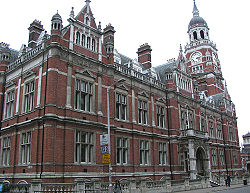Croydon Town Hall
| Croydon Town Hall | |
|
Surrey | |
|---|---|
 Croydon Town Hall | |
| Type: | Town hall |
| Location | |
| Grid reference: | TQ32426540 |
| Location: | 51°22’20"N, 0°5’56"W |
| Town: | Croydon |
| History | |
| Address: | Katharine Street |
| Built 1896 | |
| By: | Charles Henman |
| Town hall | |
| Victorian | |
| Information | |
| Owned by: | Croydon Council |
Croydon Town Hall is a council building in Katherine Street, Croydon which serves as headquarters for Croydon Council. It is a Grade II listed building.[1]
History
Croydon's first town hall, which was located on the west side of the High Street, was initially intended as a market house and was completed in 1566: it was subsequently used as a town hall until it was demolished in 1807.[2] The second town hall, which was built on the site of the first town hall, was designed by Samuel Pepys Cockerell in the classical style and completed in 1808;[3] it was demolished as part of the town's High Street widening scheme in 1893.[4]
After civic leaders found that the town hall in the High Street was inadequate for their needs, they elected to construct a purpose-built town hall: they chose the site of Central Croydon railway station, which was redeveloped for council use in 1895, as part of a plan to install "Municipal Offices, Courts, a Police Station, Library and many other public purposes and yet leave a considerable margin of land which might be disposed of".[5] The building, which was designed by Charles Henman[6] in the Victorian style and built in red brick by Messrs. W.H. Lascelles & Co, was officially opened by the Prince and Princess of Wales on 19 May 1896.[5]
The design involved a symmetrical main frontage with nine bays facing onto Katherine Street; the central section featured an arched porch on the ground floor; there was a large segmented window on the first floor and five narrow round headed windows on the second floor with the borough coat of arms above.[1] A tall tower was erected adjacent to the west of the main building and to the west of that was Braithwaite Hall, with pitched roof and turret, and the corn exchange, with loggia.[1] Braithwaite Hall was named after the Revd John Masterman Braithwaite (1846–1889), a former vicar of Croydon.[7] Internally, the principal rooms were the council chamber, the mayor's parlour and the committee rooms.[5]
A statue of Queen Victoria, which was sculpted by Francis John Williamson, was erected outside the town hall in 1903.[8]
The building served as the headquarters of the ‘County Borough of Croydon’ for much of the 20th century and went to become the local seat of government of an enlarged Croydon borough on its formation in 1965. Council officers and their departments moved out to Taberner House, to the south-east of the town hall, in 1967.[9]
The whole building, including the council chamber, the mayor's parlour and committee rooms, was extensively renovated in the late-1980s and early 1990s. This enabled parts of the building which were not required for council meetings to be re-purposed as an arts venue known as the Croydon Clocktower in 1994.[10] At the same time a new public library was established in a new structure behind the town hall and the old local studies library was converted for use as the new David Lean Cinema.[5] Meanwhile, Braithwaite Hall continued to be made available for concerts, theatre and children's shows.[11]
After Taberner House became inefficient to operate, council officers and their departments moved to Bernard Weatherill House, located to the south of the town hall, in May 2013.
Outside links
References
- ↑ 1.0 1.1 1.2 National Heritage List 1188798: Municipal Buildings, comprising the clock tower, public library, and Corn Exchange, and including the area balustrade which incorporates a war memorial and a statue of Queen Victoria (Grade II listing)
- ↑ Brayley, Edward Wedlake; Britton, John (17 September 2017). "A topographical history of Surrey, by E.W. Brayley assisted by J. Britton and E.W. Brayley, jun. The geological section by G. Mantell". https://books.google.co.uk/books?id=ULcHAAAAQAAJ&pg=PA22.
- ↑ Anderson, John Corbet (17 September 1882). A Short Chronicle Concerning the Parish of Croydon in the County of Surrey. Ballantyne, Hanson and Company. p. 201. https://archive.org/details/ashortchronicle00andegoog. "croydon town hall."
- ↑ 'London's Town Halls' (Historic England), page 42
- ↑ 5.0 5.1 5.2 5.3 "Town Hall". 8 April 2014. https://www.croydon.gov.uk/democracy/themayor/historic/townhall. Retrieved 16 September 2017.
- ↑ Nikolaus Pevsner: The Buildings of England: London 2: South, 1983 Penguin Books ISBN 978-0-300-09651-4page 214
- ↑ "Braithwaite Hall, Croydon Clocktower, London". The Independent. 23 January 1996. https://www.independent.co.uk/arts-entertainment/site-unseen-braithwaite-hall-croydon-clocktower-london-1325435.html.
- ↑ "Statue: Queen Victoria statue - Croydon". London Remembers. https://www.londonremembers.com/memorials/queen-victoria-statue-croydon. Retrieved 5 April 2020.
- ↑ "Taberner House, London". Skyscraper News. http://www.skyscrapernews.com/buildings.php?id=1478. Retrieved 23 April 2020.
- ↑ "David Lean Cinema returns to Croydon Clocktower Auditorium". East London Lines. https://web.archive.org/web/20180129195628/http://www.eastlondonlines.co.uk/2015/12/david-lean-cinema-returns-to-croydon-clocktower-auditorium/. Retrieved 5 April 2020.
- ↑ "Concert: Ida's march". News Shopper. 11 September 2002. https://www.newsshopper.co.uk/news/6299424.concert-idas-march/.